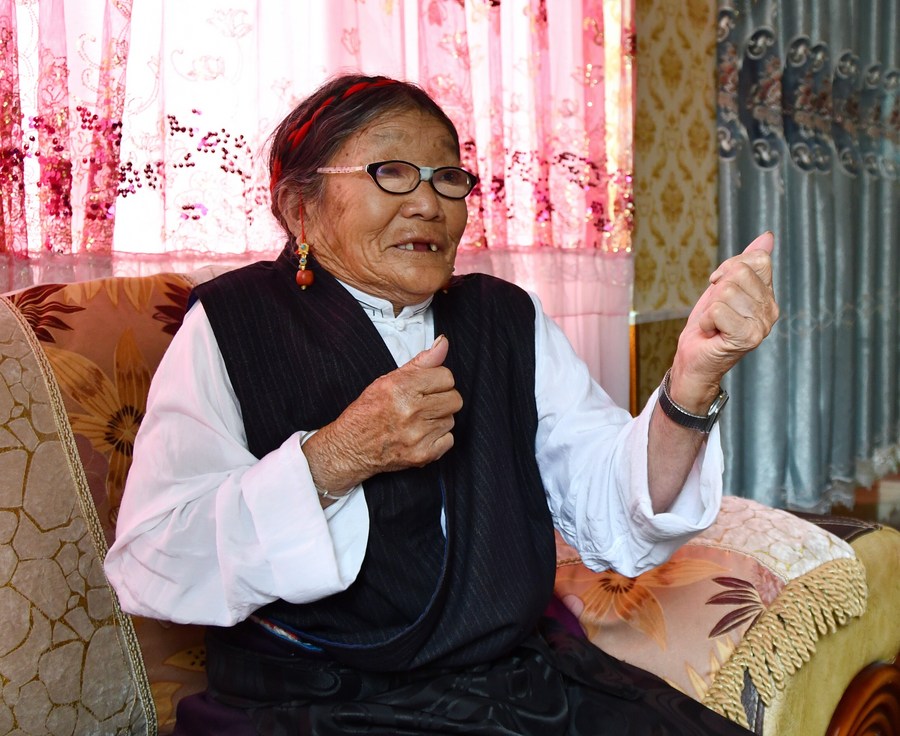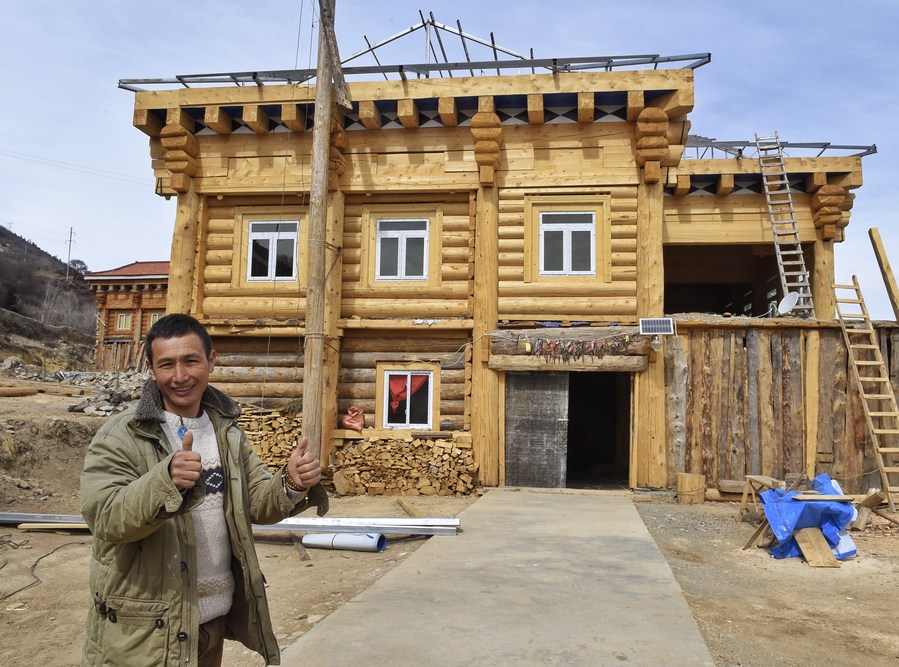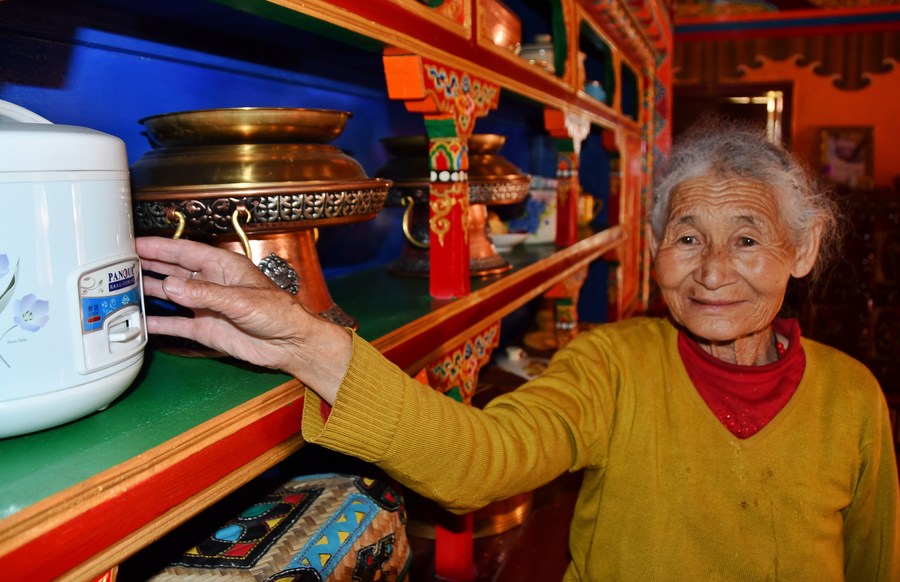-- Garze Tibetan Autonomous Prefecture in southwest China's Sichuan Province celebrates the 70th anniversary of its establishment this year.
-- Over the past 70 years, two major changes have transformed fortunes in Garze.
-- Democratic reforms in the 1950s led to the emancipation of serfs in the prefecture.
-- China's anti-poverty efforts helped farmers and herders cast off poverty.
CHENGDU, Sept. 30 (Xinhua) -- On rainy days, Changchub Drolma's legs ache more than ever. Years of toiling as a serf during her childhood has taken its toll on her health.
"As a child, I was the 'property' of the landowner, and so were the other kids," said Changchub Drolma, 85.
"I was a skinny girl, but I had to work day and night for the landlord," she said, still remembering the bright sun that hurt her eyes.
Changchub Drolma is a resident of Garze Tibetan Autonomous Prefecture, southwest China's Sichuan Province. Established in 1950, the highland prefecture has 1.2 million permanent residents, with 82 percent of them being Tibetan.

Changchub Drolma reacts when talking about the past at home in Dawu County of Tibetan Autonomous Prefecture of Garze, southwest China's Sichuan Province, July 30, 2020. (Xinhua/Zhou Xiangji)
Earlier this month, authorities held a ceremony to celebrate the 70th anniversary of its establishment.
Changchub Drolma was once a serf in the area before democratic reforms transformed the prefecture in the 1950s. The reforms freed serfs and brought them land.
These days, you are more likely to find Changchub Drolma sitting in the small hotel run by her family in the county of Dawu in Garze, her legs under warm blankets, and her cheerful grandchildren and great-grandchildren playing around.
"Gone are the dark days when we had no freedom, food or houses of our own," she said.
EMANCIPATION OF SERFS IN GARZE
In 1935, Changchub Drolma was born into a family of serfs in the county of Dawu.
As serfs, her impoverished parents would always lower their heads out of fear and insecurity. To survive in the feudal society of serfdom, Changchub Drolma learned at a young age how to plow, herd cows and sheep, wash dishes and clean floors in exchange for food.
"I had to start working at the break of dawn. I starved all day, and I had to resist it," she recalled. "At sunset, I knew I could get some highland barley."
"When I was too weak to work because of starvation, I secretly ate some of the left-over tea leaves from the landlord and chewed on them," she said.
"I once saw a serf who was wrongly accused of stealing. The landlord grabbed him by the hair, hung him for three days and beat him until blood covered his body."

A once poverty-stricken villager poses for a photo with his new house under construction in Geka Village of Mazi Town, Dawu County of Tibetan Autonomous Prefecture of Garze, southwest China's Sichuan Province, March 11, 2017. (Xinhua/Liu Kun)
In her memory, childhood was all about skinny body, dirty face and hard work.
"I thought it was my destiny," she said. "I thought all serfs were born to work endlessly, suffer and die."
Changchub Drolma's life took a drastic turn in 1956 when democratic reforms came to Garze and serfs started to fight for freedom. With the help of the People's Liberation Army (PLA) and local authorities, she joined the militia.
At that time, the county had just gone through reforms, and many rebels started to resort to bloodshed, killing PLA soldiers and local officials.
The young Changchub Drolma joined in the fight against the rebels.
"I remember seeing PLA soldiers being carried off from the battlefield on horseback with blood trailing them the whole way," she said. "I guarded the gate of the county Party committee with a gun in the day and carried water to the PLA soldiers at night."
Following the battle, the serfs won houses, land and human rights.
"We learned that our destiny is in our own hands," she said.
In the ensuing decades in Garze, what was a broken world has gradually turned a new page: mud shacks turned into new Tibetan-style houses, electricity replaced candles and cement roads took over mud trails.
Now, Changchub Drolma gets up early in the morning and makes steamed buns and buttered tea.
"Although I am 85, I still work because I want the kids to know that hard-working people can live better lives through their own efforts," she said.
FROM POVERTY TO PROSPERITY
The democratic reforms liberated farmers and herders, but high altitudes, low oxygen and poor transportation in Garze remained to be stumbling blocks for development.
Then comes China's nationwide poverty-relief efforts. The aim is to eradicate absolute poverty by the end of this year.
In the Tibetan Yuthok New Village in Garze's Derge County, villager Tsering Raga has developed a hobby: eating hotpot.

Tsering Raga shows her copper pots and an electric cooker in Tibetan Yuthok New Village in Derge County of Tibetan Autonomous Prefecture of Garze, southwest China's Sichuan Province, Aug. 5, 2020. (Xinhua/Zhou Xiangji)
"When I eat hotpot, I feel warm and the atmosphere around me is lively," said Tsering Raga, 76.
Tsering Raga used to live in an old village tucked away in the mountains at an altitude of about 4,000 meters above sea level. It took one day to ride a horse from the bottom of the mountain to the old village.
"Our family of four used to make ends meet in the mountain village by growing barley," she recalled. "Winter was the worst time because we had no electricity. On windy days, the cold gusts of wind blew right through the house, and on rainy days, we had to use basins to catch rainwater."
Drinking water was also a problem, and locals had to dig ice for water in the valleys.
In 2017, through a government-initiated relocation program, all villagers moved off the mountain and into their new Tibetan houses, which feature road lamps and wide village roads, with potato flowers dotting their yards.

Photo taken on Aug. 5, 2020 shows a view of the Tibetan Yuthok New Village in Derge County of Tibetan Autonomous Prefecture of Garze, southwest China's Sichuan Province. (Xinhua/Zhou Xiangji)
After moving, Tsering Raga's son found a job in the county and brought back many "novel items," including two copper pots for making hotpot and an electric cooker.
"I really enjoy eating hotpot with my family," she said.
Like Tsering Raga, more than 50,000 impoverished people in Garze have cast off poverty by relocation.
Over the course of 70 years, Garze has seen economic aggregate surging from 34 million yuan (about 5 million U.S. dollars) in 1950 to 38.8 billion yuan in 2019. GDP per capita rose from 66 yuan in 1950 to 32,440 yuan last year.
About 223,000 impoverished local residents have shaken off poverty.
"The past 70 years have seen people work hard to make Garze what it is today -- a beautiful picture of the prefecture rising from closure to openness, from left-behind to advancement and from poverty to prosperity," said Liu Chengming, secretary of the Garze prefectural committee of the Communist Party of China.
"In the future, there are more happiness ahead for the Garze people," said Liu.
(Reporting by Zhong Qun, Zhou Xiangji, Lu Youyi and Kang Jinqian; Video reporter: Yang Jin; Video editor: Wu Yao)■



